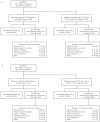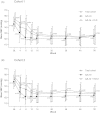Safety and tolerability of azilsartan medoxomil in subjects with essential hypertension: a one-year, phase 3, open-label study
- PMID: 26817604
- PMCID: PMC4819839
- DOI: 10.3109/10641963.2015.1081213
Safety and tolerability of azilsartan medoxomil in subjects with essential hypertension: a one-year, phase 3, open-label study
Abstract
This 56-week phase 3, open-label, treat-to-target study, involving 2 consecutive, non-randomized cohorts, evaluated the safety and tolerability of azilsartan medoxomil (AZL-M) in essential hypertension (mean baseline blood pressure [BP] 152/100 mmHg). All subjects (n = 669) initiated AZL-M 40 mg QD, force-titrated to 80 mg QD at week 4, if tolerated. From week 8, subjects could receive additional medications, starting with chlorthalidone (CLD) 25 mg QD (Cohort 1) or hydrochlorothiazide (HCTZ) 12.5-25 mg QD (Cohort 2), if required, to reach BP targets. Adverse events (AEs) were reported in 75.9% of subjects overall in the two cohorts (73.8% Cohort 1, 78.5% Cohort 2). The most common AEs were dizziness (14.3%), headache (9.9%) and fatigue (7.2%). Transient serum creatinine elevations were more frequent with add-on CLD. Clinic systolic/diastolic BP (observed cases at week 56) decreased by 25.2/18.4 mmHg (Cohort 1) and 24.2/17.9 mmHg (Cohort 2). These results demonstrate that AZL-M is well tolerated over the long term and provides stable BP improvements when used in a treat-to-target BP approach with thiazide-type diuretics.
Keywords: Hypertension; angiotensin receptor blocker; azilsartan; chlorthalidone; diuretic; hydrochlorothiazide.
Figures



Similar articles
-
Comparison of long-term safety of fixed-dose combinations azilsartan medoxomil/chlorthalidone vs olmesartan medoxomil/hydrochlorothiazide.J Clin Hypertens (Greenwich). 2017 Sep;19(9):874-883. doi: 10.1111/jch.13009. Epub 2017 Jul 6. J Clin Hypertens (Greenwich). 2017. PMID: 28681550 Free PMC article. Clinical Trial.
-
Safety, tolerability, and efficacy of azilsartan medoxomil with or without chlorthalidone during and after 8 months of treatment for hypertension.J Clin Hypertens (Greenwich). 2015 Mar;17(3):183-92. doi: 10.1111/jch.12474. Epub 2015 Jan 24. J Clin Hypertens (Greenwich). 2015. PMID: 25619410 Free PMC article. Clinical Trial.
-
Azilsartan medoxomil plus chlorthalidone reduces blood pressure more effectively than olmesartan plus hydrochlorothiazide in stage 2 systolic hypertension.Hypertension. 2012 Aug;60(2):310-8. doi: 10.1161/HYPERTENSIONAHA.111.188284. Epub 2012 Jun 18. Hypertension. 2012. PMID: 22710649 Clinical Trial.
-
Evaluating the Safety and Tolerability of Azilsartan Medoxomil Alone or in Combination With Chlorthalidone in the Management of Hypertension: A Systematic Review.Curr Hypertens Rev. 2021;17(3):217-227. doi: 10.2174/1573402117666210112144505. Curr Hypertens Rev. 2021. PMID: 33438552
-
Single-pill Combination Therapy of Azilsartan Medoxomil/Chlorthalidone for Treatment of Hypertension: A Systematic Review.Clin Ther. 2020 Jul;42(7):1390-1403. doi: 10.1016/j.clinthera.2020.05.015. Epub 2020 Jun 25. Clin Ther. 2020. PMID: 32595000
Cited by
-
Comparison of long-term safety of fixed-dose combinations azilsartan medoxomil/chlorthalidone vs olmesartan medoxomil/hydrochlorothiazide.J Clin Hypertens (Greenwich). 2017 Sep;19(9):874-883. doi: 10.1111/jch.13009. Epub 2017 Jul 6. J Clin Hypertens (Greenwich). 2017. PMID: 28681550 Free PMC article. Clinical Trial.
-
A Systematic Literature Review and Network Meta-analysis of Azilsartan Medoxomil Compared to Other Anti-hypertensives Efficacy in Lowering Blood Pressure Amongst Mild to Moderate Hypertensive Patients.Adv Ther. 2024 Dec;41(12):4498-4517. doi: 10.1007/s12325-024-02997-5. Epub 2024 Oct 16. Adv Ther. 2024. PMID: 39412629 Free PMC article.
-
Antihypertensive effect of azilsartan versus olmesartan in patients with essential hypertension: a meta-analysis.Ir J Med Sci. 2019 May;188(2):481-488. doi: 10.1007/s11845-018-1859-1. Epub 2018 Jul 3. Ir J Med Sci. 2019. PMID: 29971568
-
Efficacy and safety of different doses of azilsartan medoxomil in patients with hypertension: A protocol of a network meta-analysis.Medicine (Baltimore). 2019 Sep;98(36):e17050. doi: 10.1097/MD.0000000000017050. Medicine (Baltimore). 2019. PMID: 31490400 Free PMC article.
-
Efficacy and safety of azilsartan medoxomil, an angiotensin receptor blocker, in Korean patients with essential hypertension.Clin Hypertens. 2018 Feb 7;24:2. doi: 10.1186/s40885-018-0086-4. eCollection 2018. Clin Hypertens. 2018. PMID: 29445520 Free PMC article.
References
-
- Edarbi (azilsartan medoxomil) tablets. U.S. prescribing information. Arbor Pharmaceuticals, LLC, Atlanta, GA, USA. Jul 2014. Available at: http://www.accessdata.fda.gov/drugsatfda_docs/label/2014/200796s006lbl.pdf [last accessed 13 Oct 2014]
-
- Edarbi (azilsartan medoxomil) tablets. Summary of product characteristics. Takeda Pharma A/S, Taastrup, Denmark. Oct 2014. Available at: http://www.ema.europa.eu/docs/en_GB/document_library/EPAR_-_Product_Info... [last accessed 13 Oct 2014]
-
- Zaiken K, Cheng JW. Azilsartan medoxomil: a new angiotensin receptor blocker. Clin Ther. 2011;33:1577–89. - PubMed
-
- Perry CM. Azilsartan medoxomil: a review of its use in hypertension. Clin Drug Investig. 2012;32:621–39. - PubMed
Publication types
MeSH terms
Substances
LinkOut - more resources
Full Text Sources
Other Literature Sources
Medical
